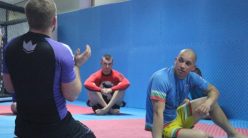“Technique is queen, strength is king, you need both to have kingdom.” Ross Enamait
When you enter the world of Combat Sports you quickly realize that the popular myth that “technique always beats strength” is nothing more than an old kung-fu movies slogan embraced from martial arts community for the simple reason that illusions sell better.
I have to disappoint you… technique beats strength only if the strength is unskilled, but everyone has seen the power lifter that instructors use to demonstrate the effectiveness of the techniques, and advanced students use as a ragdoll, who after just couple of months training becomes one of the hardest sparring partners in the gym. Why? Simply because strength is skill as well, and by neglecting it, you are neglecting whole area of the fighting game.
When equally skilled opponents meet, the odds are in favour to the stronger one. Prove of that is that practically there is no high level fighter in any combat sport who doesn’t dedicate time to vigorous strength and conditioning program.
However as a beginner entering the sport, who is approaching his first competition, this area, might look a bit complex and confusing. The purpose of this article is too give you a basic practical understanding and sample to start from, and I strongly encourage you to experiment and find what you enjoy doing and works best for you.
There are 4 general categories of strength capabilities:
Absolute Strength – is the amount of force that one can exert under involuntary muscle stimulation
Maximal Strength – is the amount of force that can exert under voluntary effort.
Explosive Strength – is the ability to express significant tension in minimal time.
Speed Strength – is the ability to quickly execute an unloaded movement or a movement against a relatively small external resistance.
Absolute Strength is used only in extreme survival situation, and is not subject of sports. If you are training under guidance of good coach Explosive and Speed Strength should be incorporated and targeted in your training sessions, in this article I will target the Maximal Strength. Developing Maximal Strength is base for all other strength systems, protects you from injuries and expands your arsenal by allowing you to use some strength demanding techniques (clinch work, kata goruma throw or wrestling slams are beautiful display of the fusion of strength and technique).
Enough theory lets step towards the practical part:
Comprehensive guide for strength training design for fighters
- Exercises numbering system
A combat sport athlete while competing is operating in constantly changing conditions, which means his strength training, should target his whole body in order to imitate the competition environment of our sports. In order to target that I use numbering system to target the major muscles group, as follows:
- Shoulders
- Chest
- Biceps
- Triceps
- Back
- Legs
- Balance (might be combined with at least one of the general muscle groups per session)
In a training session I want to target ALL of them by 3 sets of one exercise per group.
Sample session (I will use mostly bodyweight exercises in the sample, in order to target a budget friendly option for fighters):
- Shoulders+7 Balance: 3 sets of Hand Stand Push Ups
- Chest: 3 sets of Dips Chest (knees to chest)
- Biceps: 3 sets of Chin Ups
- Triceps: 3 sets of Dips Triceps (legs straight)
- Back: 3 sets of Wide Grip Pull Ups
- Legs+7 Balance: 3 sets of Pistol Squats
- Number of reps
Next problem a novice in strength training has to deal with is how to avoid training to failure?
Training to failure is counterproductive for your overall strength development, and might have negative effect on your skill development: if you overstrain at your strength training, next day you will be distrait and sloppy on your skill session, which might result as gap in your game.
By choosing your exercises have in mind that you have to be able to perform between 4 and 8 reps for 3 sets in order to target the Maximum Strength system of your body.
Under 4 reps means this exercise is too hard for you
Over 8 reps means you are going towards the Strength Endurance and you have to change your exercise with another one, or to start using harder variation of it to target the Maximum Strength system.
It might take several sessions to find your exercises, but don’t worry, even if you are not able to keep all the requirement at once you are still getting stronger with every training, they don’t need to be perfect. Persistence is what bring results in the sports world, so just keep training and adjust your sessions bit by bit.
Solution of that is keeping а strength training diary.
So if this is your first strength training session and you decide to experiment with the upper sample it will probably look like this:
| Muscle Groups | Exercises | Set 1 | Set 2 | Set 3 | Total Reps |
| 1+7- Shoulders | Hand Stand Push Ups | 12 | 2 | 1 | 15 |
| 2- Chest | Dips Chest | 36 | 15 | 9 | 60 |
| 3- Biceps | Chin Ups | 20 | 2 | 2 | 24 |
| 4- Triceps | Dips Triceps | 38 | 6 | 4 | 48 |
| 5- Back | Wide Grip Pull Ups | 12 | 9 | 3 | 24 |
| 6+7- Legs | Pistol Squats | 14 | 10 | 6 | 30 |
Once you have the data from your first session you can adjust your target reps number for the next session like that:
| Muscle Groups | Exercises | Total Reps | Divided by 3 sets=Reps per set |
| 1+7 Shoulders | Hand Stand Push Ups | 15 | 15/3=5 reps/set |
| 2 Chest | Dips Chest | 60 | 60/3=20 reps/set |
| 3 Biceps | Chin Ups | 24 | 24/3=8 reps/set |
| 4 Triceps | Dips Triceps | 48 | 48/3=16 reps/set |
| 5 Back | Wide Grip Pull Ups | 24 | 24/3=8 reps/set |
| 6+7 Legs | Pistol Squats | 30 | 30/3=10 reps/set |
Having that calculation done, now I know I might have to go on heavier variation or try other exercises for my Chest and Triceps.
- Targeting different muscles group every time.
Following the upper routine every time might have you too tired when you reach your Back Strength exercises, so you will barely have strength gains in that area. How to deal with that problem I learned from my friend and colleague Angel Karaivanov (NAGA grappling world champion and great coach):
So after you have your testing session, you will design your first training session this way:
| Muscle Groups | Exercises | Set 1 | Set 2 | Set 3 | Total Reps |
| 1+7- Shoulders | Hand Stand Push Ups | 5 | 5 | 5 | 15 |
| 2- Chest (new exercise) | Dips Chest + weighted vest | 8 | 8 | 8 | 24 |
| 3- Biceps | Chin Ups | 8 | 8 | 8 | 24 |
| 4- Triceps (new exercise) | Dips Triceps Chest + weighted vest | 8 | 8 | 8 | 24 |
| 5- Back | Wide Grip Pull Ups | 8 | 8 | 8 | 24 |
| 6+7- Legs | Pistol Squats | 10 | 10 | 10 | 30 |
My next session will look like this:
| Muscle Groups | Exercises | Set 1 | Set 2 | Set 3 | Total Reps |
| 2- Chest (new exercise) | Dips Chest + weighted vest | 8 | 8 | 8 | 24 |
| 3- Biceps | Chin Ups | 8 | 8 | 8 | 24 |
| 4- Triceps (new exercise) | Dips Triceps Chest + weighted vest | 8 | 8 | 8 | 24 |
| 5- Back | Wide Grip Pull Ups | 8 | 8 | 8 | 24 |
| 6+7- Legs | Pistol Squats | 10 | 10 | 10 | 30 |
| 1+7- Shoulders | Hand Stand Push Ups | 5 | 5 | 5 | 15 |
Pay attention how I moved the muscle group that was targeted first to the last exercise on my session, and now my training will start with the chest exercise.
Next session the first targeted group will be 3- Biceps and 2-Chest will move to the bottom, etc. rotating the muscle group you target first for every next session.
- Time management – how long session like this takes?
I personally think that hanging around while strength training is loss of time. Speaking about sports specifics, in combat sports we have to recover between the rounds for a minute. There is no excuse your strength training to mimic the athletic performance of your sport, so I suggest starting new set every second minute, which will leave 90-60 seconds rest between every set (anyway if you are beginner don’t hesitate to take longer rest between sets if you need). So the upper mentioned sample routine will last approximately 36 minutes. I strongly warming up and cooling down before and after strength training routine with shadow boxing. I like to do and to have my athletes performing 4 rounds of shadow boxing before and after strength training, which adds more 32 minutes for total length of a strength training session for fighters of 68 minutes, two times a week.
As conclusion: keep changing exercises to keep your routine fun, and don’t take this guide as written on stone, rather keep trying and experimenting until you find what best works for you.
All exercises mentioned are linked to demonstration videos.
Bibliography:
- Stiff, M.C. (2003a). Supertraining, 6th Edition, Supertraining Institute. Denver, CO.
- Zatsiorsky, V.M., (1995). Science and Practice of Strength Training. Human Kinetics, Champaign, II
- Verkhoshansky, Y.V. (1986) Fundamentals of Special Strength Training in Sport. Sportivny Press, Livonia, MI (original work published in 1985, Moscow, Russia: Fizkultura i Sport).
- Ross Enamait (2006) Never Gymless. An Excuse-Free System For Total Fitness.






